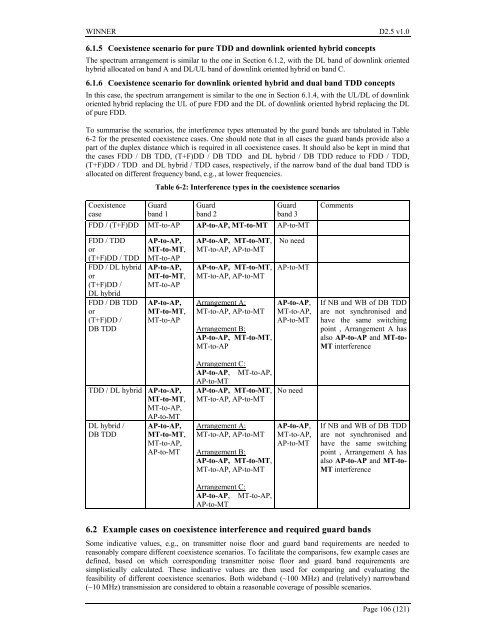IST-2003-507581 WINNER D2.5 v1.0 Duplex ... - Celtic-Plus
IST-2003-507581 WINNER D2.5 v1.0 Duplex ... - Celtic-Plus
IST-2003-507581 WINNER D2.5 v1.0 Duplex ... - Celtic-Plus
- No tags were found...
Create successful ePaper yourself
Turn your PDF publications into a flip-book with our unique Google optimized e-Paper software.
<strong>WINNER</strong> <strong>D2.5</strong> <strong>v1.0</strong>6.1.5 Coexistence scenario for pure TDD and downlink oriented hybrid conceptsThe spectrum arrangement is similar to the one in Section 6.1.2, with the DL band of downlink orientedhybrid allocated on band A and DL/UL band of downlink oriented hybrid on band C.6.1.6 Coexistence scenario for downlink oriented hybrid and dual band TDD conceptsIn this case, the spectrum arrangement is similar to the one in Section 6.1.4, with the UL/DL of downlinkoriented hybrid replacing the UL of pure FDD and the DL of downlink oriented hybrid replacing the DLof pure FDD.To summarise the scenarios, the interference types attenuated by the guard bands are tabulated in Table6-2 for the presented coexistence cases. One should note that in all cases the guard bands provide also apart of the duplex distance which is required in all coexistence cases. It should also be kept in mind thatthe cases FDD / DB TDD, (T+F)DD / DB TDD and DL hybrid / DB TDD reduce to FDD / TDD,(T+F)DD / TDD and DL hybrid / TDD cases, respectively, if the narrow band of the dual band TDD isallocated on different frequency band, e.g., at lower frequencies.Table 6-2: Interference types in the coexistence scenariosCoexistencecaseGuardband 1Guardband 2Guardband 3FDD / (T+F)DD MT-to-AP AP-to-AP, MT-to-MT AP-to-MTCommentsFDD / TDDor(T+F)DD / TDDFDD / DL hybridor(T+F)DD /DL hybridFDD / DB TDDor(T+F)DD /DB TDDAP-to-AP,MT-to-MT,MT-to-APAP-to-AP,MT-to-MT,MT-to-APAP-to-AP,MT-to-MT,MT-to-APAP-to-AP, MT-to-MT,MT-to-AP, AP-to-MTAP-to-AP, MT-to-MT,MT-to-AP, AP-to-MTArrangement A:MT-to-AP, AP-to-MTArrangement B:AP-to-AP, MT-to-MT,MT-to-APNo needAP-to-MTAP-to-AP,MT-to-AP,AP-to-MTIf NB and WB of DB TDDare not synchronised andhave the same switchingpoint , Arrangement A hasalso AP-to-AP and MT-to-MT interferenceTDD / DL hybrid AP-to-AP,MT-to-MT,MT-to-AP,AP-to-MTDL hybrid /DB TDDAP-to-AP,MT-to-MT,MT-to-AP,AP-to-MTArrangement C:AP-to-AP, MT-to-AP,AP-to-MTAP-to-AP, MT-to-MT,MT-to-AP, AP-to-MTArrangement A:MT-to-AP, AP-to-MTArrangement B:AP-to-AP, MT-to-MT,MT-to-AP, AP-to-MTArrangement C:AP-to-AP, MT-to-AP,AP-to-MTNo needAP-to-AP,MT-to-AP,AP-to-MTIf NB and WB of DB TDDare not synchronised andhave the same switchingpoint , Arrangement A hasalso AP-to-AP and MT-to-MT interference6.2 Example cases on coexistence interference and required guard bandsSome indicative values, e.g., on transmitter noise floor and guard band requirements are needed toreasonably compare different coexistence scenarios. To facilitate the comparisons, few example cases aredefined, based on which corresponding transmitter noise floor and guard band requirements aresimplistically calculated. These indicative values are then used for comparing and evaluating thefeasibility of different coexistence scenarios. Both wideband (~100 MHz) and (relatively) narrowband(~10 MHz) transmission are considered to obtain a reasonable coverage of possible scenarios.Page 106 (121)
















